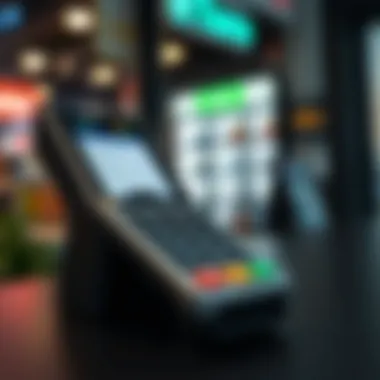Securing a Credit Card Machine for Your Business


Intro
In today's fast-paced business world, having the right tools to manage payments can make or break your venture. Credit card machines play a crucial role in facilitating smooth transactions. They not only enhance customer satisfaction by providing multiple payment options but also help streamline operations within your establishment.
Navigating the world of credit card machines, though, can feel a bit like wandering in a maze without a map. With various types to choose from, and differing fees, contracts, and support services available, making a choice can often become overwhelming. This guide aims to take the confusion out of the equation and illuminate the path toward selecting the right credit card machine for your business.
Whether you run a coffee shop, an online retail store, or a small franchise, understanding the essentials will equip you to make a choice that not only fits your operational needs but also aligns with your financial strategies. Let's delve into the core of what you need to know.
Understanding Credit Card Machines
Understanding the ins and outs of credit card machines is pivotal for any business aiming to thrive in today’s fast-paced market environment. These machines are more than just tools for processing payments; they play a crucial role in customer experience and operational efficiency. By grasping the nature of these devices, business owners can make informed decisions about which type best suits their needs.
For instance, an appreciation of credit card machines can help a business stay competitive. Nowadays, customers expect multiple payment options and convenience. Having the right credit card machine can enhance the purchasing experience, thereby fostering customer loyalty.
Moreover, comprehending these machines aids in anticipating future needs as your business grows. As sales volumes increase or customer preferences shift, a well-informed choice today preserves flexibility for tomorrow.
What is a Credit Card Machine?
A credit card machine, often referred to as a payment terminal, is a device utilized by businesses to accept credit and debit card payments from customers. While simple in functionality, these machines work through complex processes that involve secure data transmission between the customer's card and the payment processor.
These devices serve as the critical point in a transaction, whether it’s a face-to-face interaction at a retail location or an online purchase where virtual terminals may be utilized. At its core, the credit card machine bridges the gap between buyers and sellers, enabling efficient monetary exchanges.
Types of Credit Card Machines
Examining the varied types of credit card machines sheds light on their distinct benefits and suitability for different business models. Here are three main types:
Traditional Point of Sale Systems
Traditional Point of Sale (POS) systems are often fixed, taking residence at physical locations of retail or service businesses. These systems are the backbone for managing the transaction process. Their reliability is a key characteristic, made robust by connections to the internet and payment networks, thus ensuring speedy processing.
A notable feature of traditional POS systems is their ability to manage inventory and sales data simultaneously. This integration contributes to better business insights. However, one consideration is that they often come with higher upfront costs and maintenance needs, turning them into a less fluid choice for businesses with plans to scale quickly.
Mobile Credit Card Readers
Mobile credit card readers excel in flexibility and have gained traction among small businesses and entrepreneurs on the move. A defining aspect of these devices is their ability to connect with smartphones or tablets, allowing transactions to occur anywhere.
The ease of use makes mobile readers a popular choice. A unique feature is the low barrier to entry, often requiring minimal setup and investment. Nonetheless, network connectivity can be a concern; dropped signals may interrupt transactions, which could lead to frustrations for both customers and business owners.
Virtual Terminals
Virtual terminals represent the shift toward online commerce. These platforms allow businesses to process payments via web browsers, effectively opening avenues for e-commerce. The key characteristic of virtual terminals is their accessibility; business owners can accept payments from anywhere with internet access.
A standout feature is their capability to handle recurring billing and multiple payment methods seamlessly, making them beneficial for subscription-based services. But, potential pitfalls include dependence on reliable internet service and cybersecurity risks, necessitating strong measures to protect sensitive customer data.
Assessing Your Business Needs
When it comes to selecting a credit card machine, understanding your business needs is absolutely key. This stage is not just a box to tick on the checklist; it’s the backbone of your decision-making process. Why? Because the right choice can enhance operational efficiency and customer satisfaction, while the wrong one could sink you into unnecessary fees or frustrate your clientele.
Volume of Transactions
First off, let's tackle the volume of transactions your business anticipates. If you're a bustling coffee shop processing hundreds of sales in a day, your requirements differ vastly from a boutique that makes a few transactions each week. High transaction volumes often call for robust systems that can keep up with fast-paced environments.
- High-Volume Businesses: These usually benefit from traditional Point of Sale systems that offer comprehensive features like inventory management and customer insights.
- Low-Volume Businesses: A mobile credit card reader might be sufficient, providing the flexibility of accepting payments anywhere without being tied down.
Assessing your transaction volume not only impacts the type of device but also influences the fees you’ll encounter. Some processors have tiered pricing based on volume, so understanding your traffic is a must for cost efficiency.
Customer Preferences
Next in line is the preferences of your customer base. Take a moment to think about how your customers like to pay. Do they whip out their credit cards without a moment's hesitation? Or do they prefer mobile wallets like Apple Pay? Getting a grasp on these preferences might save you more than just a few headaches.
- Cashless Societies: In locales where people seldom carry cash, ensuring you have options for wireless payments is vital.
- Diverse Payment Options: Offering various payment methods can make customers feel more comfortable. Some might appreciate the option to split bills or use their loyalty rewards.
Taking time to understand your clientele's payment habits can lead to better sales performance and higher customer retention.
Nature of Business
The nature of your business also plays a significant role in determining the right credit card machine. Retail shops, restaurants, and service providers have distinctly different needs. For instance, restaurants might require machines that allow splitting payments among different patrons at a table. In contrast, an online service provider will lean towards a virtual terminal.
- Retail Stores: Typically, traditional POS systems provide the comprehensive tracking and management needed for physical locations.
- E-commerce: A virtual terminal paired with a reliable payment gateway is often best for businesses selling products or services online, easing transaction management.
- Service Providers: Mobile credit card readers can empower tradesmen and service industry workers by allowing quick payment solutions on the go.
Choosing the right equipment depends heavily on aligning with the specific demands immediate to your unique business model.
Assessing your unique business needs for a credit card machine is not just about picking the first device that looks shiny. It's about finding the right fit that can adapt as your business grows and evolves.


By carefully assessing these elements—transaction volume, customer preferences, and the very nature of your business—you position yourself to make informed decisions that directly impact your operational success. Keep these mightily important factors in the forefront of your planning as you venture into the world of credit card machines.
Exploring Payment Processors
Having the right payment processor can lead to several benefits, like accepting different payment methods and ensuring quick transaction times. Moreover, different payment processors feature unique tools and services that can help tailor the setup to your specific needs.
Role of a Payment Processor
A payment processor's primary role is to facilitate the transfer of funds from the customer to the merchant's bank account. In essence, it allows your business to accept various forms of payments, such as credit cards and online transactions. When a customer uses their credit card, the processor encrypts sensitive data, forwards it to the bank, and checks if the funds are available. This process happens in seconds.
In addition to handling transactions, payment processors often provide valuable features, like fraud detection, chargeback management, and reporting tools. Choosing the right processor can make a significant impact on the way your business handles payments and can also enhance security measures against potential risks.
Popular Payment Processing Companies
When delving into the realm of payment processors, several names come to the forefront due to their reliability and features. Below, you'll find a few notable processors and what makes them stand out.
Square
Square has built a name for itself by providing straightforward and accessible solutions for small businesses. One of its key characteristics is the ability to accept payments anywhere, thanks to its mobile products. The Square Reader allows merchants to turn their smartphones into card-processing machines. This flexibility makes it a favored choice, especially for vendors at markets or events where space is limited.
However, while Square's transaction fees can be competitive, they can add up quickly for businesses with a high sales volume. Additionally, it may lack some advanced features that larger retailers may require, but for small startups, it's often a solid pick.
PayPal
PayPal is a widely recognized name in digital transactions, and its reputation isn't without reason. With its long-standing history and trustworthiness, it's a go-to for many e-commerce businesses seeking a reliable payment method. One significant advantage of PayPal is its versatility; it allows payments from different sources, such as credit cards, bank transfers, and even from PayPal accounts, making it convenient for customers.
On the flip side, some merchants find PayPal's fees to be a bit steep, particularly for international transactions. Plus, customer support has been a common criticism, as users can encounter tedious resolution processes, primarily if issues arise. Nevertheless, for businesses ready to leverage its wide acceptance, PayPal remains an appealing option.
Stripe
Stripe is often highlighted for its user-friendly interface and robust integration capabilities, making it a major player especially among tech-savvy startups or companies looking for customization. One of its distinct features is the ability to create a tailored payment experience on your website, fitting seamlessly with existing branding. This ability allows businesses to maintain more control over the payment process, which is a significant asset.
However, Stripe's ease of use does come at a cost. For those who aren't technologically inclined, the setup may prove complicated. Additionally, while it supports various international currencies, there are occasional service disruptions reported by users. Still, for a business that values customization and flexibility, Stripe is often a compelling choice.
"Choosing a payment processor is not just about fees; it’s about ensuring a smooth transaction experience for your customers."
Understanding payment processors and their differences is a crucial step towards selecting the best solution for your business needs. In a world where fast and secure transactions are paramount, investing time into researching options can pay off considerably in the long run.
For further reading, check these resources:
Evaluating Transaction Fees
When you're venturing into the realm of credit card machines for your business, understanding transaction fees is more critical than it might seem at first glance. Every swipe, tap, or click can incur costs that can quickly add up, potentially eating into your profit margins. Knowing how these fees work is essential for making informed decisions that affect your bottom line.
Understanding Fee Structures
Transaction fees aren’t just one-size-fits-all; instead, they come in various shapes and sizes. The typical fee structure includes:
- Interchange Fees: This is the fee charged by the card-issuing bank to the merchant's bank for processing a transaction. Often these fees can range from 1.5% to 3.5% depending on several factors, including the type of card and the transaction method.
- Service Fees: Flat fees that a payment processor might levy for providing their services. This can be a fixed monthly charge or an annual fee.
- Assessment Fees: Charged by credit card networks like Visa or Mastercard, this fee helps them maintain their payment network. It tends to be a small percentage added on top of the interchange rate.
Understanding the variance in these fees helps you anticipate the overall cost of processing. Without a grasp on how these elements interact, you could easily find your expenses spiraling.
Comparing Rates
Once you've wrapped your head around the different elements that contribute to transaction fees, the next step is to dive into comparing rates across different processors. This can feel overwhelming given the number of options out there, but breaking it down into smaller parts can be useful. Here’s how you can approach it:
- Gather Information: Start by soliciting quotes from various payment processors. Make sure to ask for detailed breakdowns that include interchange, service, and assessment fees.
- Look Beyond the Surface: A processor might advertise low transaction fees but could compensate with hidden fees or unfavorable terms. Dig deep and get clarity on all potential costs.
- Consider Transaction Volume: If you expect high sales volume, some processors may offer tiered pricing that could save you money in the long run.
- Negotiate: Don’t hesitate to negotiate terms if you’re in a position to do so. Loyalty often pays, especially if you have a solid transaction history.
"In the end, it’s about finding a balance between cost and value in financial transactions." By understanding each component of transaction fees, you can make more intelligent, budget-conscious decisions for your business.
By evaluating transaction fees carefully and actively seeking the best rates, you’ll be better positioned to maximize profits and build sustainable growth in your business.
Contract Considerations
When you're diving into the process of acquiring a credit card machine for your business, understanding the contract is paramount. A solid contract lays the foundation for a successful merchant services partnership, ensuring you have a clear grasp of what to expect regarding fees, support, and terms of service. Each section of the contract demands careful scrutiny, as it could affect the financial health of your operation in the long haul.
Key Elements to Consider:
- Clarity: Always look for clear language in the contract. Terms that are too vague might hide fees or conditions that can catch you off guard later.
- Flexibility: Contracts can differ in their terms of adjustment. Some allow you to modify certain aspects, like fees or support options, after a set period.
- Obligations: Pay close attention to your obligations as a merchant, including any commitment you need to fulfill to maintain the agreement.
The role of contracts cannot be overstated; they help in defining the landscape of your payment processing experience. Given the variety of companies and their offerings, having a comprehensive contract can make or break your choice of credit card machine and processor.
Length of Contract


The length of the contract is one of those nitty-gritty details that can really matter in the long run. Contracts can vary from a few months to several years, and it’s essential to weigh the pros and cons of each option.
Opting for a short-term contract might seem appealing if you're unsure of your long-term needs, but the catch is often in the higher fees that accompany such agreements. Companies may book you with steep rates just because they know you won’t stick around for long. On the other hand, longer contracts can yield lower fees, but they might tie you down when your business needs change.
- Pros of Longer Contracts:
- Cons of Longer Contracts:
- Potentially lower transaction fees
- Stability in service costs
- Limited flexibility to switch providers
- Possible relevance issues if your business pivots
Before signing on the dotted line, ask yourself if the length suits your current business model and future projections. The last thing you want is to be stuck in a contract that doesn't serve your evolving needs.
Early Termination Fees
One aspect of credit card machine contracts that tends to ruffle feathers are early termination fees. These fees can be like a guillotine if you decide you’re no longer satisfied with your service. It’s crucial to understand what those penalties entail before committing to any agreement.
Imagine you’ve signed a two-year contract, and after six months, you find the service lacking. Some providers might hit you with hefty fees for breaking that contract prematurely. The charges can range from a few hundred dollars to as much as the total remaining value of the contract.
Examples of what to look out for:
- Flat Fees: Pay a specific amount for breaking the contract early.
- Pro-rated Fees: Fees that decrease based on the length of time you've used the service before terminating.
To avoid surprises, ask beforehand what their policies are regarding early terminations. Possibly conduct thorough research on different providers to spot trends or common practices in their fee structures.
Epilogue
In the world of business, every detail matters. When securing a credit card machine, diligent examination of the contract, especially concerning its length and potential early termination fees, is vital. Make your decision based on what's best for you today while considering what may work for you tomorrow. As you proceed through this journey, remember that knowing your obligations and the flexibility of your contract will put you on the road to smarter decisions in your business.
Ensuring Customer Support
Importance of Reliable Support
In the fast-paced landscape of today’s business world, every second counts. If a credit card machine malfunctions, it can impede transactions and ultimately affect sales. This is where reliable support steps in. Having access to support that understands your system can prevent minor issues from blossoming into major headaches. Businesses that fail to prioritize customer support often find themselves battling not just technical issues, but also customer dissatisfaction and lost revenue.
Reliable support also plays a pivotal role in fostering trust between you and your payment processor. If you know that help is just a call away, it eases your worries and lets you focus more on your core business activities.
Types of Support Offered
Understanding the types of customer support available can help you make informed decisions—not just when securing a credit card machine, but also in navigating operational challenges later. Here’s a deeper dive into some common support avenues:
Phone Support
Phone support offers a direct line to customer service representatives, making it one of the most immediate ways to address issues.
Key Characteristic: Accessibility is a defining feature of phone support. Customers can speak to a live representative, which allows for real-time resolutions.
Unique Feature: Many credit card processing companies provide support during business hours, with some even extending their hours for high-volume clients. While on the phone, you can delve into complicated issues that may not be easily resolved through text-based methods.
Advantages: Quick turnaround times can help you resolve issues faster. It’s also a more personal approach, which many users prefer.
Disadvantages: However, wait times can vary, and during busy periods, you could be left hanging on the line longer than you'd like.
Online Resources
Online resources can be a goldmine for troubleshooting and education, offering a self-service approach to resolving issues.
Key Characteristic: Accessibility at any hour makes online resources attractive. Customers can access FAQs, how-to guides, and video tutorials whenever it suits them best.
Unique Feature: Many companies have comprehensive knowledge bases that allow you to search for specific topics, giving a tailored approach to support.
Advantages: With online resources, you can find answers to common problems without needing to wait for assistance. This is particularly helpful for those who prefer to get things done independently.
Disadvantages: However, not every issue will be covered online, and the lack of human interaction can leave some users frustrated if their queries are more complex.
Live Chat
Live chat combines the immediacy of phone support with the convenience of online resources, offering a unique advantage for many.
Key Characteristic: Real-time communication through text can be easier for some users, especially those who may be shy about picking up the phone.
Unique Feature: Many platforms enable you to send screenshots or other relevant files, making it easier for support agents to understand the issue at hand.
Advantages: You can multitask while chatting, making it a flexible option for busy business owners.
Disadvantages: However, the quality of responses can vary depending on the availability of chat agents, which sometimes leads to longer resolution times.


In summary, ensuring customer support should be a priority when selecting a credit card machine for your business. Understanding the different types of support can empower you as a business owner to make decisions that not only safeguard your transactions but also enhance your customer experience.
Overall, the essence of customer support lies in providing peace of mind, allowing you to focus on growing your business rather than worrying about your payment processing capabilities.
Integrating with Existing Systems
Integrating a credit card machine with your existing systems is a critical step in ensuring seamless operation within your business. When a credit card processor collaborates effectively with your existing technology, it opens the door to numerous benefits that can significantly enhance your overall efficiency. This section will delve into the specific elements of integration, the overall benefits, and vital considerations to keep in mind when making your choice.
Compatibility with POS Software
One of the first things to consider is whether the credit card machine is compatible with your Point of Sale (POS) system. A well-aligned setup can streamline processes, reducing the time spent on transactions and minimizing the chances of errors. If you’re using a well-known POS software like Square or Clover, it's advisable to check their compatibility list before moving ahead.
The right credit card machine should communicate effortlessly with your POS, ensuring that sales data synchronizes in real-time. This means:
- Reduced Errors: Manual entry can lead to mistakes. A smooth integration often eliminates the need for manual input.
- Real-time Tracking: Financial data becomes accessible instantly, allowing for better analysis and reporting.
It’s crucial to check whether the software provider offers smooth integration support with your chosen credit card processor. Usually, listed integrations can save you headaches later on.
Inventory Management Integration
Considering how vital inventory management is to running any business, having your credit card machine work in harmony with your inventory system is invaluable. This sort of integration provides a comprehensive view of stock levels and sales performance, shining a light on what's hot and what's not.
Flowing inventory data from sales directly into your inventory management software means:
- Automatic Updates: When a sale is made, stock levels adjust automatically, keeping you up to speed without manual checks.
- Reduced Overstock: Understanding which items are trending and which are gathering dust helps in managing stock more efficiently.
When looking for a credit card machine, inquire specifically about integration capabilities with established inventory management solutions, such as QuickBooks or Fishbowl. Not all processors cater to this need, so this research can pay off down the road.
A well-integrated credit card system is a linchpin for operational success, allowing businesses to focus on growth rather than getting bogged down by technical issues.
Finalizing the Purchase
Finalizing the purchase of a credit card machine is a pivotal step in ensuring smooth transactions for your business. At this stage, the potential costs and benefits can significantly impact your operational efficiency. It's important to methodically consider various elements before making a commitment. First off, ensuring that the historical data of the processor aligns with your assessment criteria is key. Also, it’s essential to look for signs of stability in the service they offer. Remember, a machine is only as good as the support that comes with it.
When it comes to actual benefits, obtaining a suitable credit card machine can facilitate quicker transactions, improve customer satisfaction, and provide better overall data insights. Keep in mind that a hasty decision can lead to operational headaches. Thus, a deliberate approach in assessing features, costs, and aptness against your specific business needs will pay dividends.
"When it comes to payment technology, don’t just dip your toes; take the plunge only when you are ready to swim."
Making the Decision
Reaching a decision on the right credit card machine requires a careful analysis of your business situation. Start by reviewing the features that you deem necessary. For instance, does your business primarily serve customers face-to-face or is it more e-commerce focused? If you have a brick-and-mortar setup, a traditional point of sale system might be your best bet. In contrast, mobile credit card readers can provide the flexibility a roving business might require.
Cost also plays a crucial role. Assess transaction fees and monthly rates carefully. They can range from a low flat fee to variable charges depending on the volume. This will impact your bottom line, so make sure your choice doesn’t take a huge chunk out of your profits. Furthermore, reviews and feedback from similar businesses can give insights on reliability and ease of use. Use this information for your preliminary decision framework.
Here’s a quick checklist to keep in mind:
- Assess transaction volumes: Anticipate your expected transaction count.
- Feature necessities: List which features are non-negotiable for your operations.
- Research reviews: Read experiences of similar businesses with certain machines.
- Understand fees: Pay close attention to hidden fees that may arise in contracts.
Setting Up the Hardware
Setting up your newly acquired credit card machine involves a couple of tactical steps. First, it’s essential to follow the manufacturer’s instructions methodically. Whatever the type of machine you have selected, from a traditional system to a mobile device, initial configurations should be conducted according to the provided guidelines. However, here are some common issues that may arise during this phase.
A frequent hiccup involves connecting your machine to the internet or POS system. Make sure your network is robust enough to support these devices. After all, when the customer decides to pay, waiting to connect can kill the moment. Test the device multiple times during setup to ensure it operates smoothly.
Also, configure settings according to the kind of transactions you expect. You might want to enable contactless payments, which are becoming the norm. Finally, training your staff is essential. They must be comfortable and knowledgeable about the machine to assist customers effectively. A well-trained team can significantly cut down on the errors that might delay transactions or create dissatisfaction among patrons.
Here’s a short setup checklist to guide the process:
- Follow the installation guide: Always prioritize the manufacturer’s directions.
- Check network connectivity: Ensure stable connections to prevent transaction failures.
- Configure payment options: Set up various payment methods like cards, mobile payments, etc.
- Train your team: Ensure everyone knows how to operate the machine efficiently and effectively.
By diving deep into these steps, businesses can make informed choices that will lead to smoother operations and more satisfied customers.
Monitoring Transactions
Monitoring transactions is a crucial aspect of managing a business that accepts credit card payments. The ability to effectively keep an eye on sales and assess payment processing efficiency can make a world of difference in identifying trends, managing cash flow, and ensuring operational success.
When discussing transaction monitoring, the goal is to not just observe but to analyze the data available to you. Why is this important? Well, for starters, monitoring transactions allows businesses to track their sales performance in real-time. This means having the capacity to see which products are moving off the shelves and which ones may be gathering dust. By noting these patterns, businesses can adjust inventory and marketing strategies accordingly.
Keeping Track of Sales
Keeping track of sales extends beyond simple record-keeping. It’s about establishing a system that provides insights into daily, weekly, or monthly performance. Here are several components to consider:
- Automated Reporting: Most credit card machines come with software that offers automated reporting. Use those tools rather than relying on pen and paper. You’ll be amazed by how much easier it is to compile data into useful reports.
- Sales Trends: Identify peak sales times or seasonal trends. If you notice your sales peak during holiday seasons or weekends, you might consider ramping up stock or even adjusting your staffing hours accordingly.
- Customer Preferences: Knowing what your customers buy can provide invaluable insights into customer preferences. If a particular product consistently comes up as a top-seller, it would be wise to consider increasing its visibility or adding more associated items.
Assessing Payment Processing Efficiency
Paying attention to the efficiency of your payment processing can help minimize lost revenue and improve customer satisfaction. Having a swift and smooth process for accepting payments isn’t just about convenience; it can significantly affect customer loyalty. Here’s what to keep in mind:
- Transaction Speed: Monitor how long it takes to process payments. Customers dislike waiting in line, so a lagging system can hurt customer satisfaction. If your system is slow, you might need to upgrade your processing hardware or software.
- Error Rate: Keeping an eye on the number of failed transactions can help identify issues. If payments are frequently declined or errors occur, this could point to problems with your software or payment processor. Pay attention to these metrics to prevent loss of sales.
- Payment Method Trends: Knowing which payment methods customers prefer can shape how you approach payment options. Are most customers using credit cards, debit, or mobile payments? This understanding can help you cater to your paying clientele appropriately.
By diligently monitoring transactions, businesses can make informed decisions that positively impact the bottom line and enhance operational effectiveness. Not only does this practice provide insights into sales and payment trends, but it ultimately contributes to a smoother experience for both the business and its customers.







